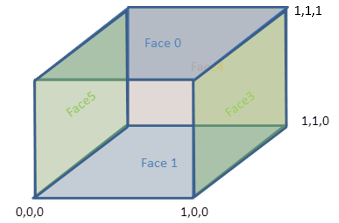11.5.3 Elements per Object
| Topic Version | 1 | Published | 09/11/2015 | |
| For Standard | RESQML v2.0.1 | |||
Unlike most of the elements in the table that have shared indexing across objects, the “elements per object” indexable elements are defined on a per object basis. For example, the “faces” indexable element enumerates all of the faces where a face shared between cells will only appear once in the enumeration. In contrast, the “faces per cell” indexable element counts a face each time it appears in a cell. For example, for an IJK grid there are 6 x NI x NJ x NK faces per cell but far fewer faces. Figure 11.5.3-1 is an example of the local cell face numbering for an IJK grid cell: 0…5. In more detail, to index face n of cell m, then the “faces per cell” index will be 6*m+n, where m and n are both zero-based indices. This enumeration is much easier to construct than that for the faces themselves, which depends on the fault structure of the grid, and the split column edge indexing, not just the grid topology.

For the unstructured elements, the ordering of these elements is part of the explicit
description of the grid geometry. For column-layer elements, the ordering is implicit. By
convention, the top () and bottom (
) faces always come
first, followed by the side faces. Similarly, the top nodes per cell are numbered before the
bottom nodes per cell.